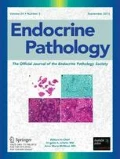Abstract
Human pituitary tumor transforming gene (hPTTG1) was recently identified as a proto-oncogene, which is a regulator of the cell cycle, as a homolog of yeast securin and a transcriptional activator of several angiogenic factors. Here we examined the relationships of hPTTG1 expression with cell proliferation, expression of the angiogenic factor, VEGF (vascular endothelial growth factor), and numbers of the blood vessels in the normal and/or adenomatous pituitary. With the exception of TSHoma, the expression of hPTTG1 was significantly higher in pituitary adenomas than in the normal pituitary gland. The cell proliferation activity was higher in pituitary adenomas than in the normal pituitary. Pituitary cell proliferation was significantly correlated with the level of hPTTG1 expression in the normal pituitary tissue, but there was no such correlation in the adenomas. The significant correlation of hPTTG1 with the VEGF expression and the numbers of the blood vessels was elucidated in pituitary adenomas. It is particularly noteworthy that immunohistochemical double staining indicated co-localization of VEGF in many hPTTG1-positive tumor cells. In conclusion, higher levels of hPTTG1 expression contribute to the pathobiology of pituitary adenomas by promoting angiogenesis rather than by activating cell proliferation, whereas hPTTG1 expression is related to mitotic activity in the normal pituitary gland.
Similar content being viewed by others
References
Minematsu T, Miyai S, Suzuki M, Yamazaki M, Takekoshi S, Osamura RY. Molecular and histological studies of pituitary tumorigenesis using experimental animal models. Acta Histochem Cytochem 38:87–92, 2005.
Pei L, Melmed S. Isolation and characterization of a pituitary tumor-transforming gene (PTTG) Mol Endocrinol 11:433–441, 1997.
Dominguez A, Ramos-Morales F, Romero F, et al. hpttg, a human homologue of rat pttg, is overexpressed in hematopoietic neoplasms. Evidence for a transcriptional activation function of hPTTG. Oncogene 17:2187–2193, 1998.
Wang Z, Melmed S. Characterization of murin pituitary tumor transforming gene (PTTG) and its promoter. Endocrinology 141:763–771, 2000.
Zou H, McGarry TJ, Bernal T, Kirschner MW. Identification of a vertebrate sister-chromatid separation inhibitor involved in transformation and tumorigenesis. Science 285:418–422, 1999.
Ramos-Morales F, Dominguez A, Romero F, et al. Cell cycle regulated expression and phosphorylation of hpttg proto-oncogene product. Oncogene 19:403–409, 2000.
Gardner R, Putnam CW, Weinert T. RAD53, DUN1 and PDS1 define two parallel G2/M checkpoint pathways in budding yeast. EMBO J 18:3173–3185, 1999.
Wang Z, Yu R, Melmed S. Mice lacking pituitary tumor transforming gene show testicular and splenic hypoplasia, thymic hyperplasia, thrombocytopenia, aberrant cell cycle progression, and premature centromere division. Mol Endocrinol 15:1870–1879, 2001.
Zhang X, Horwitz GA, Heaney AP, et al. Pituitary tumor transforming gene (PTTG) expression in pituitary adenomas. J Clin Endocrinol Metab 84:761–767, 1999.
Solbach C, Roller M, Fellbaum C, Nicoletti M, Kaufmann M. PTTG mRNA expression in primary breast cancer: a prognostic marker for lymph node invasion and tumor recurrence. Breast 13:80–81, 2004.
Heaney AP, Nelson V, Fernando M, Horwitz G. Transforming events in thyroid tumorigenesis and their association with follicular lesions. J Clin Endocrinol Metab 86:5025–5032, 2001.
Heaney AP, Singson R, McCabe CJ, Nelson V, Nakashima M, Melmed S. Expression of pituitary-tumour transforming gene in colorectal tumours. Lancet 355:716–719, 2000.
Puri R, Tousson A, Chen L, Kakar SS. Molecular cloning of pituitary tumor transforming gene 1 from ovarian tumors and its expression in tumors. Cancer Lett 163:131–139, 2001.
Shibata Y, Haruki N, Kuwabara Y, et al. Expression of PTTG (pituitary tumor trans-forming gene) in esophageal cancer. Jpn J Clin Oncol 32:233–237, 2002.
Wen C-Y, Nakayama T, Wang A-P, et al. Expression of pituitary tumor transforming gene in human gastric carcinoma. World J Gastroenterol 10:481–483, 2004.
Saez C, Japon MA, Ramos-Morales F, et al. hpttg over-expressed in pituitary adenomas and other primary epithelial neoplasias. Oncogene 18:5473–5476, 1999.
Boelaert K, McCabe CJ, Tannahill LA, et al. Pituitary tumor transforming gene and fibroblast growth factor-2 expression: potential prognostic indicators in differentiated thyroid cancer. J Clin Endocrinol Metab 88:2341–2347, 2003.
Zhang X, Horwitz GA, Prezant TR, et al. Structure, expression, and function of human pituitary tumor-transforming gene (PTTG). Mol Endocrinol 13:156–166, 1999.
Abbud RA, Takumi I, Barker EM, et al. Early multipotential pituitary focal hyperplasia in the alpha-subunit of glycoprotein hormone-driven pituitary tumor-transforming gene transgenic mice. Mol Endocrinol 19:1383–1391, 2005.
Ishikawa H, Heaney AP, Yu R, Horwitz GA, Melmed S. Human pituitary tumor-transforming gene Metab 86:867–874, 2001.
McCabe CJ, Boelaert K, Tannahill LA, et al. Vascular endothelial growth factor, its receptor KDR/Flk-1, and pituitary tumor transforming gene in pituitary tumors. J Clin Endocrinol Metab 87:4238–4244, 2002.
Osamura RY, Komatsu N, Nakahashi E, Watanabe K. Light and electron microscopical combined staining by immunohistochemical and enzyme histochemical methods using rat prolactin-secreting pituitary tumors. Hitochem J 12:371–379, 1980.
Heaney AP, Horwitz GA, Wang Z, Singson R, Melmed S. Early involvement of estrogen-induced pituitary tumor transforming gene and fibroblast growth factor expression in prolactinoma pathogenesis. Nat Med 5:1317–1321, 1999.
Minematsu T, Miyai S, Kajiya H, Suzuki M, Sanno N, Takekoshi S, Teramoto A, Osamura RY. Recent progress in studies of pituitary tumor pathogenesis. Endocrine 28:37–41, 2005.
Yu R, Melmed S. Pituitary tumor transforming gene: an update. Front Horm Res 32:175–185, 2004.
Hunter JAC, Skelly RH, Aylwin SJB, et al. The relationship between pituitary tumour transforming gene (PTTG) expression and in vitro hormone and vascular endothelial growth factor (VEGF) secretion from human pituitary adenomas. Eur J Endocrinol 148:203–211, 2003.
Horwitz GA, Miklovsky I, Heaney AP, Ren S-G, Melmed S. Human pituitary tumor-transforming gene (PTTG1) motif suppresses prolactin expression. Mol Endocrinol 17:600–609, 2003.
Pei L. Activation of mitogen-activated protein kinase cascade regulates pituitary tumor-transforming gene transactivation function. J Biol Chem 275:31191–31198, 2000.
Pei L. Identification of c-myc as a down-stream target for pituitary tumor-transforming gene. J Biol Chem 276:8484–8491, 2001.
Ishikawa H, Heaney AP, Yu R, Horwits GA, Melmed S. Human pituitary tumor-transforming gene induces angiogenesis. J Clin Endocrinol Metab 86:867–874, 2001.
Author information
Authors and Affiliations
Corresponding author
Rights and permissions
About this article
Cite this article
Minematsu, T., Suzuki, M., Sanno, N. et al. PTTG overexpression is correlated with angiogenesis in human pituitary adenomas. Endocr Pathol 17, 143–153 (2006). https://doi.org/10.1385/EP:17:2:143
Issue Date:
DOI: https://doi.org/10.1385/EP:17:2:143




